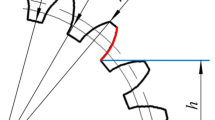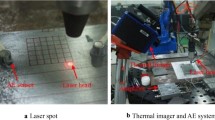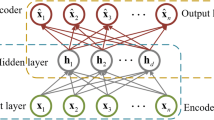Abstract
The grinding process is employed to provide a high-quality surface finish and tight dimensional tolerances to the manufactured components. However, it has the disadvantage of generating a large amount of heat during machining that is mostly transferred to the workpiece when employing conventional grinding wheels, which makes it highly susceptible to thermal damage. In terms of the different thermal damage associated with this process, grinding burn deserves special attention, as it affects the aesthetic aspect of the machined components. Since there is an increasing demand for productivity and high-quality products, the use of systems to monitor grinding burn becomes crucial when global competitiveness is in evidence. In this study, a novel approach, based on time-frequency images of acoustic emission signals and convolutional neural networks was proposed to monitor grinding burn. Experimental data were obtained from grinding tests on N2711 grade steel under different cutting conditions. Three different time-frequency analyses, including the short-time Fourier transform, the continuous wavelet transform, and the Hilbert-Huang transform, were used to generate the images that served as input for the CNN models. Through the proposed approach, grinding burn was successfully recognized, as the highest accuracy obtained by the models was 99.4% on the test dataset. This result is superior when considering those reported in the literature, in which conventional machine learning techniques are employed for grinding burn monitoring.












Similar content being viewed by others
References
Alagumurthi N, Palaniradja K, Soundararajan V (2007) Heat generation and heat transfer in cylindrical grinding process - A numerical study. Int J Adv Manuf Technol 34:474–482. https://doi.org/10.1007/s00170-006-0619-y
Teixeira PHO, Rego RR, Pinto FW, de Oliveira Gomes J, Löpenhaus C (2019) Application of Hall effect for assessing grinding thermal damage. J Mater Process Technol 270:356–364. https://doi.org/10.1016/j.jmatprotec.2019.02.019
Deiva Nathan R, Vijayaraghavan L, Krishnamurthy R (1999) In-process monitoring of grinding burn in the cylindrical grinding of steel. J Mater Process Technol 91:37–42. https://doi.org/10.1016/S0924-0136(98)00408-7
Kwak JS, Ha MK (2004) Neural network approach for diagnosis of grinding operation by acoustic emission and power signals. J Mater Process Technol 147:65–71. https://doi.org/10.1016/j.jmatprotec.2003.11.016
Santa-Aho S, Vippola M, Sorsa A et al (2012) Development of Barkhausen noise calibration blocks for reliable grinding burn detection. J Mater Process Technol 212:408–416. https://doi.org/10.1016/j.jmatprotec.2011.10.003
Liu Q, Chen X, Gindy N (2005) Fuzzy pattern recognition of AE signals for grinding burn. Int J Mach Tools Manuf 45:811–818. https://doi.org/10.1016/j.ijmachtools.2004.11.002
Kwak JS, Song JB (2001) Trouble diagnosis of the grinding process by using acoustic emission signals. Int J Mach Tools Manuf 41:899–913. https://doi.org/10.1016/S0890-6955(00)00082-1
Neto RFG, Marchi M, Martins C, et al (2014) Monitoring of grinding burn by AE and vibration signals. In: ICAART 2014 - Proceedings of the 6th International Conference on Agents and Artificial Intelligence. https://doi.org/10.5220/0004753602720279
Yang Z, Yu Z (2013) Experimental study of burn classification and prediction using indirect method in surface grinding of AISI 1045 steel. Int J Adv Manuf Technol 68:2439–2449. https://doi.org/10.1007/s00170-013-4882-4
Dotto FRL, de Aguiar PR, Bianchi EC et al (2003) Automatic detection of thermal damage in grinding process by artificial neural network. Rem Rev Esc Minas 56:295–300. https://doi.org/10.1590/s0370-44672003000400013
Lauro CH, Brandão LC, Baldo D, et al (2014) Monitoring and processing signal applied in machining processes - A review. Meas J Int Meas Confed. https://doi.org/10.1016/j.measurement.2014.08.035
Yünlü L, Çolak O, Kurbanoǧlu C (2014) Taguchi DOE analysis of surface integrity for high pressure jet assisted machining of Inconel 718. In: Procedia CIRP. https://doi.org/10.1016/j.procir.2014.04.056
Teti R, Jemielniak K, O’Donnell G, Dornfeld D (2010) Advanced monitoring of machining operations. CIRP Ann - Manuf Technol 59:717–739. https://doi.org/10.1016/j.cirp.2010.05.010
Han X, Wu T (2013) Analysis of acoustic emission in precision and high-efficiency grinding technology. Int J Adv Manuf Technol 67:1997–2006. https://doi.org/10.1007/s00170-012-4626-x
He B, Wei C, Ding S, Shi Z (2019) A survey of methods for detecting metallic grinding burn. Meas J Int Meas Confed. https://doi.org/10.1016/j.measurement.2018.10.093
Ribeiro DMS, Aguiar PR, Fabiano LFG, D'Addona DM, Baptista FG, Bianchi EC (2017) Spectra measurements using piezoelectric diaphragms to detect burn in grinding process. IEEE Trans Instrum Meas 66:3052–3063. https://doi.org/10.1109/TIM.2017.2731038
Yang Z, Yu Z (2012) Grinding wheel wear monitoring based on wavelet analysis and support vector machine. Int J Adv Manuf Technol 62:107–121. https://doi.org/10.1007/s00170-011-3797-1
Griffin JM, Chen X (2009) Multiple classification of the acoustic emission signals extracted during burn and chatter anomalies using genetic programming. Int J Adv Manuf Technol 45:1152–1168. https://doi.org/10.1007/s00170-009-2026-7
Gao Z, Lin J, Wang X, Liao Y (2019) Grinding burn detection based on cross wavelet and wavelet coherence analysis by acoustic emission signal. Chinese J Mech Eng (English Ed 32: https://doi.org/10.1186/s10033-019-0384-0
Yang Z, Yu Z, Xie C, Huang Y (2014) Application of Hilbert-Huang Transform to acoustic emission signal for burn feature extraction in surface grinding process. Meas J Int Meas Confed 47:14–21. https://doi.org/10.1016/j.measurement.2013.08.036
Hübner HB, da Silva RB, Duarte MAV, da Silva MB, Ferreira FI, de Aguiar PR, Baptista FG (2020) A comparative study of two indirect methods to monitor surface integrity of ground components. Struct Health Monit:147592172090344. https://doi.org/10.1177/1475921720903442
Zhu X, Hou D, Zhou P, Han Z, Yuan Y, Zhou W, Yin Q (2019) Rotor fault diagnosis using a convolutional neural network with symmetrized dot pattern images. Meas J Int Meas Confed 138:526–535. https://doi.org/10.1016/j.measurement.2019.02.022
Verstraete D, Ferrada A, Droguett EL, Meruane V, Modarres M (2017) Deep learning enabled fault diagnosis using time-frequency image analysis of rolling element bearings. Shock Vib 2017:1–17. https://doi.org/10.1155/2017/5067651
Cheng C, Li J, Liu Y, Nie M, Wang W (2019) Deep convolutional neural network-based in-process tool condition monitoring in abrasive belt grinding. Comput Ind 106:1–13. https://doi.org/10.1016/j.compind.2018.12.002
Aghazadeh F, Tahan A, Thomas M (2018) Tool condition monitoring using spectral subtraction and convolutional neural networks in milling process. Int J Adv Manuf Technol 98:3217–3227. https://doi.org/10.1007/s00170-018-2420-0
Kothuru A, Nooka SP, Liu R (2019) Application of deep visualization in CNN-based tool condition monitoring for end milling. Procedia Manuf 34:995–1004. https://doi.org/10.1016/j.promfg.2019.06.096
Tran MQ, Liu MK, Tran QV (2020) Milling chatter detection using scalogram and deep convolutional neural network. Int J Adv Manuf Technol 107:1505–1516. https://doi.org/10.1007/s00170-019-04807-7
Zhu W, Zhuang J, Guo B, Teng W, Wu F (2020) An optimized convolutional neural network for chatter detection in the milling of thin-walled parts. Int J Adv Manuf Technol 106:3881–3895. https://doi.org/10.1007/s00170-019-04899-1
Cohen MX (2014) Analyzing neural time series data: theory and practice. MIT Press
Cios KJ, Pedrycz W, Swiniarski RW, Kurgan LA (2007) Data mining: a knowledge discovery approach
Munger P (1998) Beyond Fourier: The Wavelet Transform. In: Peters TM, Williams J (eds) The Fourier Transform in Biomedical Engineering. Birkhäuser Boston, Boston, pp 129–173
Zak A (2011) Continuous wavelet transform in hydroacoustics signals analysis. Hydroacoustics 14:267–274
Rother A, Jelali M, Söffker D (2015) A brief review and a first application of time-frequency-based analysis methods for monitoring of strip rolling mills. J Process Control 35:65–79. https://doi.org/10.1016/j.jprocont.2015.08.010
Maity R (2018) Statistical methods in hydrology and hydroclimatology
Kok JN, Koronacki J, de Mantaras RL, et al (2007) Knowledge discovery in databases: PKDD 2007: 11th European Conference on Principles and Practice of Knowledge Discovery in Databases, Warsaw, Poland, September 17-21, 2007, Proceedings. Springer
Li JP, Zhao J, Wickerhauser V et al (2003) Wavelet analysis and its applications. World Scientific Publishing Company
Huang NE, Shen Z, Long SR, Wu MC, Shih HH, Zheng Q, Yen NC, Tung CC, Liu HH (1998) The empirical mode decomposition and the Hubert spectrum for nonlinear and non-stationary time series analysis. Proc R Soc A Math Phys Eng Sci 454:903–995. https://doi.org/10.1098/rspa.1998.0193
Gaci S (2016) A new ensemble empirical mode decomposition (EEMD) denoising method for seismic signals. Energy Procedia, In. https://doi.org/10.1016/j.egypro.2016.10.026
Szegedy C, Liu W, Jia Y, et al (2015) Going deeper with convolutions. In: Proceedings of the IEEE Computer Society Conference on Computer Vision and Pattern Recognition. https://doi.org/10.1109/cvpr.2015.7298594
Bardinas J, Aldrich C, Napier L (2018) Predicting the operating states of grinding circuits by use of recurrence texture analysis of time series data. Processes. 6. https://doi.org/10.3390/pr6020017
Kwaśnicka H, Jain LC (2018) Bridging the semantic gap in image and video analysis. Springer
Wang H, Xu J, Yan R, Gao RX (2020) A new intelligent bearing fault diagnosis method using SDP representation and SE-CNN. IEEE Trans Instrum Meas 69:2377–2389. https://doi.org/10.1109/TIM.2019.2956332
Emad O, Yassine IA, Fahmy AS (2015) Automatic localization of the left ventricle in cardiac MRI images using deep learning. In: Proceedings of the Annual International Conference of the IEEE Engineering in Medicine and Biology Society, EMBS
Cirrincione G, Kumar RR, Mohammadi A, Kia SH, Barbiero P, Ferretti J (2020) Shallow versus deep neural networks in gear fault diagnosis. IEEE Trans Energy Convers:1. https://doi.org/10.1109/tec.2020.2978155
Mitiche I, Jenkins MD, Boreham P, et al (2019) Deep complex neural network learning for high-voltage insulation fault classification from complex bispectrum representation. In: European Signal Processing Conference. https://doi.org/10.23919/EUSIPCO.2019.8903052
Balasooriya NM, Nawarathna RD (2018) A sophisticated convolutional neural network model for brain tumor classification. In: 2017 IEEE International Conference on Industrial and Information Systems, ICIIS 2017 - Proceedings. https://doi.org/10.1109/ICIINFS.2017.8300364
Wang J, Mo Z, Zhang H, Miao Q (2019) A deep learning method for bearing fault diagnosis based on time-frequency image. IEEE Access 7:42373–42383. https://doi.org/10.1109/ACCESS.2019.2907131
Mechelli A, Vieira S (2019) Machine learning: methods and applications to brain disorders. Academic Press
Keçeli AS, Kaya A, Can AB (2018) Combining 2D and 3D deep models for action recognition with depth information. SIViP 12:1197–1205. https://doi.org/10.1007/s11760-018-1271-3
Boashash B, Azemi G, Ali Khan N (2015) Principles of time-frequency feature extraction for change detection in non-stationary signals: applications to newborn EEG abnormality detection. Pattern Recogn 48:616–627. https://doi.org/10.1016/j.patcog.2014.08.016
Zhang L, Sun Y, Zhang X, Bai Y (2017) Blind equalization in neural networks: theory, algorithms and applications
Zhang G, Eddy Patuwo B, Hu MY (1998) Forecasting with artificial neural networks: the state of the art. Int J Forecast 14:35–62. https://doi.org/10.1016/S0169-2070(97)00044-7
Marchi M, Baptista FG, de Aguiar PR, Bianchi EC (2015) Grinding process monitoring based on electromechanical impedance measurements. Meas Sci Technol 26:045601. https://doi.org/10.1088/0957-0233/26/4/045601
Aguiar PR, Serni PJA, Dotto FRL, Bianchi EC (2006) In-process grinding monitoring through acoustic emission. J Braz Soc Mech Sci Eng 28. https://doi.org/10.1590/S1678-58782006000100014
Dotto FRL, De Aguiar PR, Bianchi EC et al (2006) Automatic system for thermal damage detection in manufacturing process with Internet monitoring. J Braz Soc Mech Sci Eng 28:153–160. https://doi.org/10.1590/S1678-58782006000200004
Yang Z, Yu Z, Wu H, Chang D (2014) Laser-induced thermal damage detection in metallic materials via acoustic emission and ensemble empirical mode decomposition. J Mater Process Technol 214:1617–1626. https://doi.org/10.1016/j.jmatprotec.2014.03.009
Babel R, Koshy P, Weiss M (2013) Acoustic emission spikes at workpiece edges in grinding: origin and applications. Int J Mach Tools Manuf 64:96–101. https://doi.org/10.1016/j.ijmachtools.2012.08.004
Qiu T, Guo Y (2018) Signal processing and data analysis. Walter de Gruyter GmbH & Co KG
Liu Y, Tan Y, Xie H, Wang W, Gao Z (2014) Time-frequency analysis of non-stationary fusion plasma signals using an improved Hilbert-Huang transform. Rev Sci Instrum 85:073502. https://doi.org/10.1063/1.4887415
Yang WX (2008) Interpretation of mechanical signals using an improved Hilbert-Huang transform. Mech Syst Signal Process 22:1061–1071. https://doi.org/10.1016/j.ymssp.2007.11.024
Russakovsky O, Deng J, Su H, Krause J, Satheesh S, Ma S, Huang Z, Karpathy A, Khosla A, Bernstein M, Berg AC, Fei-Fei L (2015) ImageNet large scale visual recognition challenge. Int J Comput Vis 115:211–252. https://doi.org/10.1007/s11263-015-0816-y
Esteva A, Kuprel B, Novoa RA, Ko J, Swetter SM, Blau HM, Thrun S (2017) Dermatologist-level classification of skin cancer with deep neural networks. Nature. 542:115–118. https://doi.org/10.1038/nature21056
Buetti-Dinh A, Galli V, Bellenberg S, Ilie O, Herold M, Christel S, Boretska M, Pivkin IV, Wilmes P, Sand W, Vera M, Dopson M (2019) Deep neural networks outperform human expert’s capacity in characterizing bioleaching bacterial biofilm composition. Biotechnol Rep 22:e00321. https://doi.org/10.1016/j.btre.2019.e00321
Dua S, Chowriappa P (2012) Data mining for bioinformatics
Rosa JLG (2016) Artificial neural networks: models and applications. BoD--Books on Demand
Acknowledgments
The authors acknowledge the financial support of the Post Graduate Program of Mechanical Engineering of UFU.
Funding
This study was financed by the Coordenação de Aperfeiçoamento de Pessoal de Nivel Superior - Brasil (CAPES) - Finance Code 001 that sponsored the scholarship of Henrique Butzlaff Hübner.
Author information
Authors and Affiliations
Corresponding author
Additional information
Publisher’s note
Springer Nature remains neutral with regard to jurisdictional claims in published maps and institutional affiliations.
Rights and permissions
About this article
Cite this article
Hübner, H.B., Duarte, M.A.V. & da Silva, R.B. Automatic grinding burn recognition based on time-frequency analysis and convolutional neural networks. Int J Adv Manuf Technol 110, 1833–1849 (2020). https://doi.org/10.1007/s00170-020-05902-w
Received:
Accepted:
Published:
Issue Date:
DOI: https://doi.org/10.1007/s00170-020-05902-w




